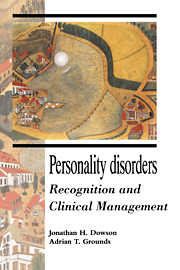Book contents
- Frontmatter
- Contents
- Acknowledgement
- Part One Recognition
- 1 Personality disorders: basic concepts and clinical overview
- 2 Specified personality disorders: clinical features
- 3 Personality disorders: less specific clinical presentations and epidemiology
- 4 Longitudinal aspects of personality disorders
- 5 Assessment of personality disorders
- Part two Clinical management
- References
- Index
2 - Specified personality disorders: clinical features
from Part One - Recognition
Published online by Cambridge University Press: 19 October 2009
- Frontmatter
- Contents
- Acknowledgement
- Part One Recognition
- 1 Personality disorders: basic concepts and clinical overview
- 2 Specified personality disorders: clinical features
- 3 Personality disorders: less specific clinical presentations and epidemiology
- 4 Longitudinal aspects of personality disorders
- 5 Assessment of personality disorders
- Part two Clinical management
- References
- Index
Summary
Validity of personality disorder syndromes
For a syndrome to have validity it must be demonstrated that its features are associated with other variables; descriptive validity involves an association with definitions of PD, while concurrent and predictive validity relate PD assessments to measurements of other variables and outcome, respectively.
A PD diagnosis based on a categorical classification of PD is ‘inherently imperfect because we can only provide an approximate match to an hypothetical construct’ (Widiger & Frances, 1985a), and the main polythetic diagnostic systems give rise to PD syndromes that have a variable degree of resemblance to the ‘ideal’ or ‘prototype’ disorders. Also, there can be overlap between diagnoses if similar or identical features occur in more than one syndrome, and co-occurrence of several PDs may be present in the same individual. Furthermore, when two or more PD syndromes co-occur, it cannot be assumed that they are independent, as interactions will occur.
The DSM-III-R and DSM-IV claim that PD syndromes can be grouped into ‘clusters’, which implies that if one PD member of the cluster is present, features of the associated PDs are more likely to co-occur than features of PDs in other clusters. The first cluster includes paranoid, schizoid and schizotypal PDs, and people with these syndromes often appear odd or eccentric. Antisocial, borderline, histrionic and narcissistic PDs form a second cluster, leading to dramatic, emotional or erratic behaviour, while the third cluster consists of avoidant, dependent, obsessive-compulsive and passive-aggressive PDs (the latter is omitted in DSM-IV). Individuals with the latter disorders often appear anxious or fearful.
- Type
- Chapter
- Information
- Personality DisordersRecognition and Clinical Management, pp. 43 - 127Publisher: Cambridge University PressPrint publication year: 1995
- 1
- Cited by



